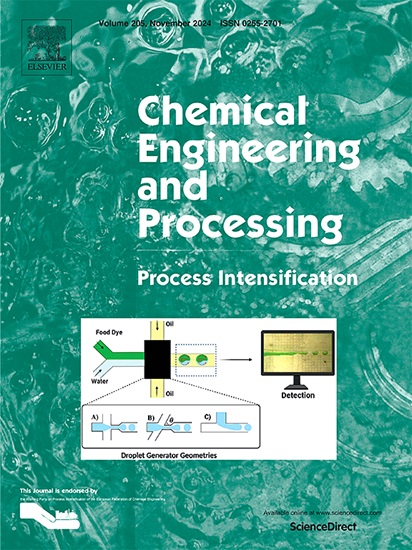Runway-shaped microchannel with flow rate insensitivity for high-throughput blood plasma extraction
IF 3.8
3区 工程技术
Q3 ENERGY & FUELS
Chemical Engineering and Processing - Process Intensification
Pub Date : 2025-05-28
DOI:10.1016/j.cep.2025.110384
引用次数: 0
Abstract
Conventional inertial microfluidic devices are plagued by a low throughput, sheath fluid dependency, and constrained operational flow rate range during plasma extraction processes. Thus, a runway-shaped inertial microfluidic device for continuous blood plasma extraction has been proposed. By integrating curved channels with semicircular obstacles into the CEA channels, the device can generate stable and enhanced Dean vortices in each loop of the channel without the need for sheath fluid assistance. This configuration effectively promoted the rapid formation of steady focusing states for particles of different diameters (5, 10, and 15 μm). The device demonstrated remarkable flow rate insensitivity (0.2 to 1.7 mL/min) for blood cell focusing, enabling plasma extraction across a wide flow rate range. For 1 % hematocrit blood sample operated at a flow rate of 1.4 mL/min, the plasma collected from outlet 3 showed a 1528-fold reduction in blood cell concentration, and the blood cell rejection efficiency reached 99.93 %. These results confirmed that the device is capable of extracting highly purified blood plasma with the advantages of simple operation, insensitivity to flow rates, and high throughput. The device is also expected to provide a favorable opportunity for the preparation and analysis of blood samples for disease diagnosis.

高通量血浆提取中流速不敏感的跑道型微通道
传统的惯性微流体装置在等离子体提取过程中受到低通量、鞘层流体依赖性和受限的操作流速范围的困扰。为此,提出了一种用于连续血浆提取的跑道型惯性微流控装置。通过将带有半圆形障碍物的弯曲通道整合到CEA通道中,该装置可以在通道的每个回路中产生稳定且增强的Dean涡流,而无需鞘层流体的辅助。这种结构有效地促进了不同直径(5、10和15 μm)粒子的稳定聚焦状态的快速形成。该装置对血细胞聚焦表现出显著的流速不敏感(0.2 ~ 1.7 mL/min),能够在很宽的流速范围内提取血浆。以1.4 mL/min的流速操作1%的血细胞比容血样时,从出口3采集的血浆血细胞浓度降低1528倍,血细胞排斥效率达到99.93%。这些结果证实了该装置能够提取高度纯化的血浆,具有操作简单、对流速不敏感、通量高的优点。该装置还有望为用于疾病诊断的血液样本的制备和分析提供有利的机会。
本文章由计算机程序翻译,如有差异,请以英文原文为准。
求助全文
约1分钟内获得全文
求助全文
来源期刊
CiteScore
7.80
自引率
9.30%
发文量
408
审稿时长
49 days
期刊介绍:
Chemical Engineering and Processing: Process Intensification is intended for practicing researchers in industry and academia, working in the field of Process Engineering and related to the subject of Process Intensification.Articles published in the Journal demonstrate how novel discoveries, developments and theories in the field of Process Engineering and in particular Process Intensification may be used for analysis and design of innovative equipment and processing methods with substantially improved sustainability, efficiency and environmental performance.

 求助内容:
求助内容: 应助结果提醒方式:
应助结果提醒方式:


